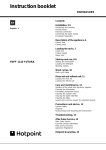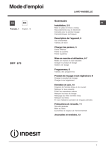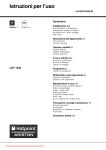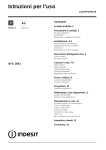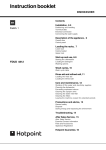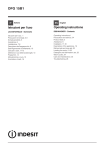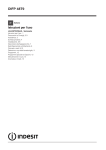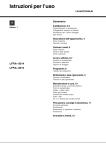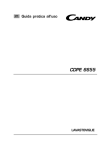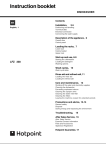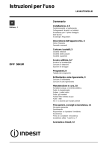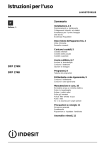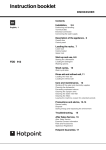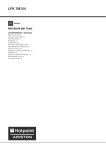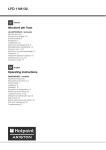Download Hotpoint-Ariston LDF 12314 Dishwasher User Guide Manual
Transcript
Istruzioni per luso LAVASTOVIGLIE EN IT Italiano, 1 English,13 Sommario Installazione, 2-3 Posizionamento e livellamento Collegamenti idraulici ed elettrici Avvertenze per il primo lavaggio Dati tecnici Descrizione dellapparecchio, 4 Vista dinsieme Pannello comandi Caricare i cestelli, 5 Cestello inferiore Cestello delle posate Cestello superiore Avvio e utilizzo, 6-7 Avviare la lavastoviglie Caricare il detersivo Opzioni di lavaggio LDF 12314 Programmi, 8 Tabella dei programmi Brillantante e sale rigenerante, 9 Caricare il brillantante Caricare il sale rigenerante Manutenzione e cura, 10 Escludere acqua e corrente elettrica Pulire la lavastoviglie Evitare i cattivi odori Pulire gli irroratori Pulizia filtro entrata acqua Pulire i filtri Se ci si assenta per lunghi periodi Precauzioni, consigli e Assistenza, 11 Sicurezza generale Smaltimento Risparmiare e rispettare lambiente Assistenza Anomalie e rimedi, 12 Downloaded from DishWasher-Manual.com Manuals Installazione 16 È importante conservare questo libretto per poterlo consultare in ogni momento. In caso di vendita, di cessione o di trasloco, assicurarsi che resti insieme allapparecchio. Leggere attentamente le istruzioni: ci sono importanti informazioni sullinstallazione, sulluso e sulla sicurezza. In caso di trasloco tenere lapparecchio in posizione verticale; se fosse necessario, inclinarlo sul lato posteriore. Posizionamento e livellamento 1. Disimballare lapparecchio e controllare che non abbia subìto danni durante il trasporto. Se fosse danneggiato non collegarlo e contattare il rivenditore. 2. Sistemare la lavastoviglie facendo aderire i fianchi o lo schienale ai mobili adiacenti o alla parete. Lapparecchio può anche essere incassato sotto a un piano di lavoro continuo* (vedi foglio di Montaggio). 3. Posizionare la lavastoviglie su un pavimento piano e rigido. Compensare le irregolarità svitando o avvitando i piedini anteriori finché lapparecchio non sia orizzontale. Un accurato livellamento dà stabilità ed evita vibrazioni, rumori e spostamenti. 4*. Per regolare laltezza del piedino posteriore, agire sulla boccola esagonale di colore rosso presente nella parte inferiore, frontale, centrale della lavastoviglie, con una chiave a bocca esagonale apertura 8 mm., girando in senso orario per aumentare laltezza e in senso antiorario per diminuirla. (vedere foglio istruzioni incasso allegato alla documentazione) Collegamenti idraulici ed elettrici Ladattamento degli impianti elettrici e idraulici per linstallazione deve essere eseguito solo da personale qualificato. La lavastoviglie non deve appoggiare sui tubi o sul cavo di alimentazione elettrica. Lapparecchio deve essere collegato alla rete di distribuzione dellacqua utilizzando tubi nuovi. Non riutilizzare i vecchi tubi. Collegamento del tubo di carico dellacqua A una presa dacqua fredda: avvitare bene il tubo di carico a un rubinetto con bocca filettata da 3/4 gas; prima di avvitare, far scorrere lacqua finché non sia limpida affinché le eventuali impurità non intasino lapparecchio. A una presa dacqua calda: nel caso di impianto centralizzato di termosifoni, la lavastoviglie può essere alimentata con acqua calda di rete purché non superi la temperatura di 60°C. Avvitare il tubo al rubinetto come descritto per la presa dacqua fredda. Se la lunghezza del tubo di carico non è sufficiente, rivolgersi a un negozio specializzato o a un tecnico autorizzato (vedi Assistenza). La pressione dellacqua deve essere compresa nei valori riportati dalla tabella Dati tecnici (vedi a lato). Fare attenzione che nel tubo non ci siano né pieghe né strozzature. Sicurezza antiallagamento Per garantire che non si generino allagamenti, la lavastoviglie: - è dotata di un sistema che interrompe lingresso dellacqua nel caso di anomalie o di perdite dallinterno. Alcuni modelli sono dotati di un dispositivo supplementare di sicurezza New Acqua Stop*, che garantisce lantiallagamento anche in caso di rottura del tubo di alimentazione. ATTENZIONE: TENSIONE PERICOLOSA! Il tubo di carico dellacqua, non deve in nessun caso, essere tagliato in quanto contiene parti sotto tensione. I tubi di carico (A) e di scarico (B) dellacqua e il cavo di alimentazione elettrica possono essere orientati verso destra o sinistra per consentire la migliore installazione (vedi figura). * Presente solo su alcuni modelli. 2 Downloaded from DishWasher-Manual.com Manuals Collegamento del tubo di scarico dellacqua Collegare il tubo di scarico, senza piegarlo, a una conduttura di scarico con diametro minimo di 4 cm. Oppure appoggiarlo al bordo di un lavandino o di una vasca; lestremità libera del tubo di scarico non deve rimanere immersa nellacqua. Lo speciale gomito* in plastica agevola una sistemazione ottimale: fissare saldamente il gomito al muro per evitare che il tubo si muova e versi lacqua fuori dallo scarico. La parte del tubo contrassegnata con la lettera A deve essere a unaltezza compresa tra 40 e 100 cm da terra (vedi figura). A Striscia anticondensa* 16 Dopo aver incassato la lavastoviglie aprire la porta e incollare la striscia adesiva trasparente sotto al ripiano in legno per proteggerlo dalla eventuale condensa. Avvertenze per il primo lavaggio Dopo linstallazione, immediatamente prima del primo lavaggio, riempire completamente dacqua il serbatoio del sale e solo dopo aggiungere circa 1 Kg di sale (vedi capitolo Brillantante e sale rigenerante): è normale che lacqua trabocchi. Selezionare il grado di durezza dellacqua (vedi capitolo Brillantante e sale rigenerante). Dopo il caricamento del sale la spia MANCANZA SALE* si spegne. Il mancato riempimento del contenitore del sale, può provocare il danneggiamento del dolcificatore dellacqua e dellelemento riscaldante. È sconsigliato usare tubi di prolunga. Collegamento elettrico Dati Tecnici Prima di inserire la spina nella presa della corrente, accertarsi che: la presa abbia la messa a terra e sia a norma di legge; la presa sia in grado di sopportare il carico massimo di potenza della macchina, indicato nella targhetta caratteristiche sulla controporta (vedi capitolo Descrizione della lavastoviglie); la tensione di alimentazione sia compresa nei valori indicati nella targhetta caratteristiche sulla controporta; la presa sia compatibile con la spina dellapparecchio. In caso contrario richiedere la sostituzione della spina a un tecnico autorizzato (vedi Assistenza); non usare prolunghe o prese multiple. Dimensioni Larghezza cm. 60 Altezza cm. 85 Profondità cm. 60 Capacità 14 coperti standard Pressione acqua alimentazione 0,05 ÷ 1MPa (0.5 ÷ 10 bar) 7,25 – 145 psi Tensione di alimentazione vedi targhetta caratteristiche Potenza totale assorbita vedi targhetta caratteristiche Fusibile vedi targhetta caratteristiche Questa apparecchiatura è conforme alle seguenti Direttive Comunitarie: -2006/95/EEC del 16/01/2007 (Bassa Tensione) e successive modifiche -89/336/EEC del 03/05/89 (Compatibilità Elettromagnetica) e successive modificazioni -97/17/EC (Etichettatura) -2002/96/CE Ad apparecchio installato, il cavo di alimentazione elettrica e la presa della corrente devono essere facilmente raggiungibili. Il cavo non deve subire piegature o compressioni. Se il cavo di alimentazione è danneggiato, deve essere sostituito dal costruttore o dal suo Servizio di Assistenza Tecnica, in modo da prevenire ogni rischio. (Vedi Assistenza) LAzienda declina ogni responsabilità qualora queste norme non vengano rispettate. * Downloaded from DishWasher-Manual.com Manuals Presente solo su alcuni modelli. 3 Descrizione dellapparecchio 16 Vista dinsieme 1. 2. 3. 4. 5. 6. 7. 8. 9. 10. 11. 12. Cestello superiore Irroratore superiore Ribaltine Regolatore altezza cestello Cestello inferiore Irroratore inferiore Cestello posate Filtro lavaggio Serbatoio sale Vaschette detersivo e serbatoio brillantante Targhetta caratteristiche Pannello comandi*** Pannello comandi Spia opzione Good Night* Spia opzione ShorTime* Indicatore luminoso nome programma Spia ON-OFF Tasto On-Off/Reset Spia Mancanza Sale* Spia Pastiglie multifunzione* Spia Extra Asciugatura* Spie Mezzo carico Superiore e Inferiorie* Indicatore luminoso tempo residuo Spia Partenza Ritardata* Tasto e Spia Avvio/Pausa Spia Mancanza Brillantante* Tasto Partenza Ritardata* Tasto Selezione Programma Tasto Pastiglie multifunzione* Tasto ShorTime * *** Solo sui modelli ad incasso totale * Presente solo su alcuni modelli. Tasto Mezzo carico* Tasto Extra Asciugatura* Tasto Good Night* Il numero e il tipo di programmi ed opzioni variano in base al modello di lavastoviglie. 4 Downloaded from DishWasher-Manual.com Manuals Caricare i cestelli Prima di caricare i cesti, eliminare dalle stoviglie i residui di cibo e vuotare bicchieri e coppe dei liquidi rimasti. Dopo aver caricato, controllare che gli irroratori ruotino liberamente. Inclinazione A Inclinazione B Inclinazione C Cesto inferiore Il cesto inferiore può contenere pentole, coperchi, piatti, insalatiere, posate ecc..secondo gli Esempi di caricamento. Piatti e coperchi grandi vanno sistemati di preferenza ai lati del cesto, facendo attenzione a non bloccare la rotazione dellirroratore superiore. Alcuni modelli di lavastoviglie, dispongono di settori reclinabili*, gli stessi si possono usare in posizione verticale per la sistemazione dei piatti oppure in posizione orizzontale per sistemare pentole e insalatiere. Cestino delle posate Il cestino delle posate può essere di tipo diverso a seconda dei modelli di lavastoviglie: non scomponibile, scomponibile, scorrevole. Il cestino non scomponibile deve essere posizionato solo nella parte anteriore del cesto inferiore. Il cestino scomponibile può essere separato in due parti, soluzione indicata quando si esegue un lavaggio a mezzo carico (sui mod. provvisti di tale opzione), può essere scorrevole, cioè posizionato in qualsiasi punto del cesto inferiore facendolo scorrere tra gli inserti fissi o reclinabili. - Sono muniti di ribaltine scorrevoli che consentono una sistemazione migliore delle posate. - Sollevare la ribaltina, farla scorrere leggermente e posizionarla nell inclinazione desiderata. Regolare laltezza del cesto superiore Per agevolare la sistemazione delle stoviglie, è possibile sistemare il cesto superiore in posizione alta o bassa. (per caricamenti Baby nei modelli provvisti di ciclo Baby, il cesto superiore deve essere regolato in posizione bassa). E preferibile regolare laltezza del cesto superiore a CESTO VUOTO. Non sollevare o abbassare MAI il cesto su un solo lato. Aprire i fermi delle guide del cesto a destra e a sinistra ed estrarre il cesto; sistemarlo in alto o in basso, farlo scivolare lungo le guide fino a far entrare anche le rotelle anteriori e chiudere i fermi (vedi figura). Se il cesto è dotato di maniglie Dual Space* (vedi figura), estrarre il cesto superiore a fine corsa, impugnare le maniglie ai lati del cesto e muovere verso lalto o verso il basso; lasciare ricadere il cesto accompagnandolo. Esempi di caricamento cesto superiore/inferiore I coltelli e gli utensili con punte taglienti devono essere sistemati nel cestino delle posate con le punte rivolte verso il basso o sistemati sulle ribaltine del cesto superiore in posizione orizzontale. Esempi di posizionamento dei cestini posate Cesto superiore Caricarvi le stoviglie delicate e leggere: bicchieri, tazze da tè e caffè, piattini, insalatiere basse, padelle, pentole basse poco sporche, secondo gli Esempi di caricamento. Tazze e tazzine, coltelli lunghi e acuminati, posate di servizio: posizionarli sulle ribaltine**. Ribaltine ad inclinazione variabile - Linclinazione consente di acquistare maggiore spazio nel cesto superiore, di posizionare calici con steli di lunghezza diversa e di migliorare le prestazioni di asciugatura. Ribaltine Baby* Nei modelli di lavastoviglie in cui è presente il Ciclo Baby vengono fornite in dotazione apposite ribaltine per il lavaggio di biberon, ghiere e tettarelle. (vedi foglio istruz. allegato alla documentazione) Stoviglie non adatte al lavaggio in lavastoviglie Oggetti di legno, con impugnatura in legno o in corno o con parti incollate. Oggetti di alluminio, rame, ottone, peltro o stagno. Stoviglie di plastica non termoresistente. Porcellane antiche o dipinte a mano. Argenteria antica. Largenteria non antica può invece essere lavata con un programma delicato e accertandosi che non sia a contatto con altri metalli. Si consiglia lutilizzo di stoviglie idonee al lavaggio in lavastoviglie. * Presente solo in alcuni modelli. ** Variabili per numero e posizione. Downloaded from DishWasher-Manual.com Manuals 5 16 Avvio e utilizzo 16 Prima accensione Scegliere la lingua Premere il tasto ON/OFF, si sente un bip breve e il display visualizza la lingua impostata. Scorrere con il tasto della PARTENZA RITARDATA per avanzare, o quello del MEZZO CARICO per tornare indietro, le lingue fino a quella desiderata, premere il tasto P per confermare la scelta, ed automaticamente si entra nella lista dei programmi di lavaggio. Ad ogni accensione successiva alla prima, la lavastoviglie visualizzerà la lista dei programmi. E possibile modificare la lingua anche dopo la prima accensione premendo contemporaneamente il tasto P ed il tasto della PARTENZA RITARDATA per alcuni secondi. Avviare la lavastoviglie 1. Aprire il rubinetto dellacqua. 2. Premere il tasto ON-OFF: si sente un breve bip, la spia ON/ OFF e il display si illuminano. 3. Aprire la porta e dosare il detersivo (vedi sotto). 4. Caricare i cestelli (vedi Caricare i cestelli) e chiudere la porta. 5. Selezionare il programma, in base alle stoviglie e al loro grado di sporco (vedi tabella dei programmi) premendo il tasto P. 6. Selezionare le opzioni di lavaggio (vedi a lato). 7. Avviare premendo il tasto Avvio: un lungo bip avvisa dellinizio del programma e viene visualizzato il nome del programma selezionato e il tempo residuo alla fine del ciclo. 8. Alla fine due bip brevi e uno lungo segnalano la fine del programma e sul display compare la frase FINE CICLO. Spegnere lapparecchio premendo il tasto ON-OFF, chiudere il rubinetto dellacqua e staccare la spina dalla presa di corrente. 9. Aspettare alcuni minuti prima di togliere le stoviglie, per evitare di scottarsi. Scaricare i cestelli iniziando da quello inferiore. * Lordine di visualizzazione dei programmi si aggiornerà in base alla frequenza del loro utilizzo. PROGRAMMI AUTO*:questo modello di lavastoviglie è dotato di un particolare sensore che può valutare il grado di sporco e impostare il lavaggio più efficiente ed economico. La durata dei programmi auto potrà variare per lntervento del sensore. Se le stoviglie sono poco sporche o sono state sciacquate precedentemente sotto lacqua, ridurre sensibilmente la dose del detersivo. Modificare un programma in corso Se si è selezionato un programma sbagliato è possibile modificarlo, purché appena iniziato: a lavaggio avviato, per cambiare ciclo di lavaggio spegnere la macchina con una pressione prolungata del tasto ON/OFF/Reset, riaccenderla con lo stesso tasto e selezionare nuovamente programma e opzioni desiderati. Aggiungere altre stoviglie Premere il tasto Avvio/Pausa, (la luce del tasto pulsa) il display visualizza PAUSA. Aprire la porta facendo attenzione alla fuoriuscita di vapore e inserire le stoviglie. Premere il tasto Avvio/Pausa (luce fissa): il ciclo riprende dopo un bip prolungato. Premendo il tasto Avvio/Pausa per mettere la macchina in pausa, il display visualizza PAUSA e si interrompe sia il programma sia lAvvio Ritardato se impostato. In questa fase non si può cambiare il programma. Interruzioni accidentali Se durante il lavaggio si apre la porta il display visualizza la frase CHIUDERE LA PORTA, o si verifica uninterruzione di corrente, il programma si interrompe. Riprende dal punto in cui si era interrotto o quando si chiude la porta o torna la luce. Caricare il detersivo Il buon risultato del lavaggio dipende anche dal corretto dosaggio del detersivo, eccedendo non si lava in modo più efficace e si inquina lambiente. Utilizzare solo detersivo per lavastoviglie. NON UTILIZZARE detersivi per lavaggio a mano. Un utilizzo eccessivo di detersivo può lasciare residui di schiuma a fine ciclo. Lutilizzo delle pastiglie è consigliato solo nei modelli dove è presente lopzione PASTIGLIE MULTIFUNZIONE. Le migliori prestazioni di lavaggio ed asciugatura, si ottengono solo con lutilizzo di detersivo in polvere, brillantante liquido e sale. vaschetta A: Detersivo per lavaggio vaschetta B: Detersivo per prelavaggio 1. Aprire il coperchio C premendo il pulsante D. 2. Dosare il detersivo consultando la Tabella dei programmi: in polvere: vaschette A e B. pastiglie: quando il programma ne richiede 1, metterla nella vaschetta A e chiudere il coperchio; quando ne richiede 2, mettere la seconda sul fondo della vasca. 3. Eliminare i residui di detersivo dai bordi della vaschetta e chiudere il coperchio fino allo scatto. Opzioni di lavaggio* Le OPZIONI possono essere impostate, modificate o azzerate solo dopo aver scelto il programma di lavaggio e prima di aver premuto il tasto Avvio/Pausa. Possono essere selezionate solo le opzioni compatibili al tipo di programma scelto. Se unopzione non è compatibile con il programma selezionato, (vedi tabella programmi) il led relativo lampeggia velocemente 3 volte e si sentono 2 bip brevi. Se viene selezionata unopzione incompatibile con unopzione precedentemente impostata, questa lampeggia 3 volte, emette 3 bip e si spegne, mentre rimane accesa lultima impostazione scelta. Per deselezionare unopzione erroneamente impostata, premere di nuovo sul tasto corrispondente. * Presente solo su alcuni modelli. 6 Downloaded from DishWasher-Manual.com Manuals Mezzo carico cesto superiore o inferiore* Se le stoviglie sono poche, si può effettuare il mezzo carico risparmiando acqua, energia e detersivo. Selezionare il programma, premere il tasto MEZZO CARICO in successione: il triangolo relativo al carico scelto si illumina e si attiva il lavaggio solo sul cesto superiore o solo su quello inferiore; un ulteriore pressione del tasto deseleziona lopzione. Il Mezzo Carico, non è compatibile con lOpzione Good Night e ShorTime. Ricordarsi di caricare le stoviglie solo sul cesto superiore o inferiore e di dimezzare la quantità di detersivo. E preferibile utilizzare detersivo in polvere. Questa opzione non è disponibile con il programma: Rapido. Partenza ritardata* È possibile posticipare da 1 a 24 ore lavvio del programma: 1. Dopo aver selezionato il programma di lavaggio desiderato ed altre eventuali opzioni, premere il tasto della PARTENZA RITARDATA: il simbolo della Partenza ritardata inizierà a lampeggiare. Con il medesimo tasto selezionare quando si desidera far iniziare il ciclo di lavaggio (da 1 a 24 ore). 2. Confermare la scelta con il tasto AVVIO/PAUSA, il simbolo smette di lampeggiare, inizia il conto alla rovescia, sul display compare la frase Parte tra..., il ritardo selezionato lampeggia ed il tasto AVVIO/PAUSA smette di pulsare (luce fissa). 3. A tempo scaduto si sente un bip lungo, la spia della PARTENZA RITARDATA si spegne, e il programma si avvia. Per deselezionare la PARTENZA RITARDATA, premere il tasto PARTENZA RITARDATA fino alla visualizzazione di OFF. Non è possibile impostare la Partenza Ritardata a ciclo avviato. Pastiglie Multifunzione* (Tabs) Con questa opzione viene ottimizzato il risultato di lavaggio ed asciugatura. Quando si usano le pastiglie multifunzione premere il tasto PASTIGLIE MULTIFUNZIONE, la spia si illumina; un ulteriore pressione deseleziona lopzione. Lopzione Pastiglie Multifunzione, comporta lallungamento del programma. Opzione ShorTime* 16 Questa opzione permette di ridurre la durata dei principali programmi mantenendo le stesse performance di lavaggio ed asciugatura. Dopo aver selezionato il programma, premere il tasto Opzione ShorTime, laccensione della spia ed un bip breve segnalano lavvenuta selezione. Per deselezionare lopzione, ripremere lo stesso tasto. Opzione Good Night* Questa opzione aumenta la silenziosità allungando la durata dei programmi, ed è ideale perchè permette di usufruire della tariffa energetica notturna. Dopo aver selezionato il programma, premere il tasto Opzione Good Night, laccensione della spia ed un bip breve segnalano lavvenuta selezione. Per deselezionare lopzione, ripremere lo stesso tasto. Le Opzioni ShorTime e Good Night, non sono compatibili tra loro. Le Opzioni ShorTime e Good Night, non sono compatibili con lopzione MEZZO CARICO. Extra Asciugatura* Per migliorare lasciugatura delle stoviglie, premere il tasto EXTRA ASCIUGATURA la spia si illumina, un ulteriore pressione deseleziona lopzione. L opzione EXTRA ASCIUGATURA, comporta lallungamento del programma. PROGRAMMA SELFCARE Questo programma igienizzante, permette di pulire a fondo linterno della lavastoviglie riducendo la formazione di cattivi odori. ATTENZIONE Il programma di lavaggio SELFCARE, va utilizzato con prodotti specifici monodose per la cura della lavastoviglie (seguire le indicazioni sulla confezione) e con lavastoviglie VUOTA. Tabella Opzioni A Avvio Ritardato B Mezzo Carico C Pastiglie Multifunz. D Extra Asciug E Shor Time F Good Night Auto Super wash Si Si SI Si Si No Normale Si Si SI Si Si Si Daily A 60’ Si Si SI No No No Lutilizzo delle pastiglie è consigliato solo dove è presente lopzione PASTIGLIE MULTIFUNZIONE. Ammollo Si Si No No No No Eco 50°C Si Si Si Si No Si Questa opzione è sconsigliata con i programmi che non prevedono luso delle pastiglie multifunzione (vedi tabella delle opzioni ). Speed 25’ Si No Si No No No Cristalli Si Si Si Si No No Auto Duo Wash Si No Si Si Si No Ultra Intensivo Si Si Si Si No No Special Guest Si Si No Si No No Baby Cycle Si No No No No No SelfCare Si No No No No No L opzione PASTIGLIE MULTIFUNZIONE rimane impostata alle successive accensioni della macchina se non deselezionata. * Presente solo su alcuni modelli. Downloaded from DishWasher-Manual.com Manuals 7 Programmi 16 Per le OPZIONI consultare la tabella Opzioni presente nella pagina dellAvvio e Utilizzo. Il numero e il tipo di programmi ed opzioni variano in base al modello di lavastoviglie. Indicazioni per la scelta dei programmi Detersivo (A) = vaschetta A (B) = vaschetta B Programma polvere liquido pastiglie Programmi che prevedono l’asciugatura Opzioni Durata del programma (tolleranza ±10%) Hrs. Min. Stoviglie e pentole molto sporche (da non usare per pezzi delicati). Auto Super wash 35 g (A) 35 ml (A) 1 (A) Si A-B-C-D-E 2:15’ Stoviglie e pentole normalmente sporche. Programma standard giornaliero. Normale 29 g (A) 6 g (B) 29 ml (A) 6 ml (B) 1 (A) Si A-B-C-D-E-F 1:45’ Daily A 60’ 25 g (A) 25 ml (A) 1 (A) No A-B-C 1:00’ Ammollo No No No No A-B 0:08’ Eco* 50°C 29 g (A) 6 g (B) 29 ml (A) 6 ml (B) 1 (A) Si A-B-C-D-F 2:45’ Speed 25’ 25 g (A) 25 ml (A) 1 (A) No A-C 0:25’ Cristalli 35 g (A) 35 ml (A) 1 (A) Si A-B-C-D 1:30’ Auto Duo Wash 35 gr (A) 35 ml A) 1 (A) Si A-C-D-E 1:43’ Ultra Intensivo 29 g (A) 6 g (B) 29 ml (A) 6 ml (B) 1 (A) 1 (fondo vasca Si A-B-C-D 2:07' Special Guest No No No Si A-B-D 0:32’ Baby Cycle 20 g (A) 20 ml (A) No Si A 1:20' SelfCare No No No No A 0:40' Sporco quotidiano in quantità limitata. (4 coperti + 1 pentola + 1 padella). Lavaggio preliminare in attesa di completare il carico al pasto successivo. Lavaggio ecologico a bassi consumi energetici, adatto a stoviglie e pentole. Ciclo economico e veloce da utilizzare per stoviglie poco sporche, subito dopo l'uso. (2 piatti +2 bicchieri + 4 posate +1 pentola + 1 padellino) Ciclo economico e veloce per stoviglie delicate, più sensibili alle alte temperature, subito dopo l'uso. (calici nel cesto superiore + piatti delicati, nel cesto inferiore). Lavaggio differenziato sui due cesti: delicato sul superiore per cristalli e bicchieri, energico per pentole sul cesto inferiore. Pentole estremamente sporche o con residui di cibo essiccato. Ciclo di risciacquo e asciugatura per stoviglie che si utilizzano raramente; solo impolverate. Ciclo igienizzante per lavare biberon, ghiere, tettarelle insieme a piatti, tazzine, bicchieri e posate. Caricare le stoviglie solo sul cesto superiore. Ciclo igienizzante di pulizia dell’interno della lavastoviglie da utilizzare solo a lavastoviglie VUOTA e con detergenti specifici. Note: Per facilitare il dosaggio del detersivo è bene sapere che: 1 cucchiaio da cucina = 15 g. di polvere = 15 ml di liquido circa. - 1 cucchiaino da cucina = 5 g.di polvere = 5 ml di liquido circa Le migliori prestazioni dei programmi Daily A 60 e Speed 25, si ottengono preferibilmente rispettando il numero di coperti specificati. * Il programma Eco, rispetta la norma EN-50242, dura più a lungo rispetto ad altri programmi ma presenta un minor consumo di energia ed in più è rispettoso con lambiente. Nota per i laboratori di Prove: per informazioni sulle condizioni della prova comparativa EN, farne richiesta allindirizzo: [email protected] 8 Downloaded from DishWasher-Manual.com Manuals Brillantante e sale rigenerante Usare solo prodotti specifici per lavastoviglie. Non usare sale alimentare o industriale nè detersivi per il lavaggio a mano. Seguire le indicazioni riportate sulla confezione. Se si usa un prodotto multifunzione, non è necessario aggiungere brillantante, si consiglia invece di aggiungere sale, specie se lacqua è dura o molto dura. Seguire le indicazioni riportate sulla confezione. Non aggiungendo né sale né brillantante è normale che le spie MANCANZA SALE* e MANCANZA BRILLANTANTE* rimangano accese. Caricare il brillantante Il brillantante facilita lasciugatura delle stoviglie facendo scivolare lacqua dalla superficie, così che non rimangano striature o macchie. Il serbatoio del brillantante va riempito: quando sul pannello si accende la spia MANCANZA BRILLANTANTE*; 1. Aprire il serbatoio ruotando il tappo (G) in senso antiorario. 2. Versare il brillantante evitando che fuoriesca. Se accade, pulire subito con un panno asciutto. 3. Riavvitare il tappo. F Non versare MAI il brillantante G direttamente allinterno della vasca. Regolare la dose di brillantante Se non si è soddisfatti del risultato dellasciugatura, è possibile regolare la dose di brillantante. Con un cacciavite girare il regolatore (F) scegliendo tra 6 posizioni (la regolazione di fabbrica è sul 4): se sulle stoviglie ci sono striature, girare verso i numeri bassi (1-3). se ci sono gocce dacqua o macchie di calcare girare verso i numeri alti (4-6). Impostazione durezza dellacqua Ogni lavastoviglie è corredata di un dolcificatore dellacqua che, utilizzando del sale rigenerante specifico per lavastoviglie, fornisce acqua priva di calcare per il lavaggio delle stoviglie. Questa lavastoviglie, consente una regolazione che riduce linquinamento ed ottimizza le prestazioni di lavaggio in funzione della durezza dellacqua. Il dato è reperibile presso lEnte erogatore dellacqua potabile. - Accendere la macchina premendo il tasto ON/OFF. - Premere il tasto P per alcuni secondi; si sentono due bip brevi, il display visualizza DUREZZA ACQUA e lampeggia lentamente sul display il numero di regolazione di durezza impostato (Il decalcificatore è impostato di fabbrica sul n° 3). - Premere il tasto PARTENZA RITARDATA (livelli da 1 a 5) o il tasto MEZZO CARICO (livelli da 5 a 1) in successione fino al Downloaded from DishWasher-Manual.com Manuals raggiungimento della durezza desiderata; premere il tasto P per confermare.(1-2-3-4-5* Vedi tabella durezza acqua), fino ad un massimo di 5 livelli. - Per uscire dalla funzione attendere 30 secondi circa o premere un altro tasto delle opzioni o spegnere la macchina con il tasto ON/OFF. Se si utilizzano le pastiglie multifunzione, riempire comunque il serbatoio del sale. °dH 0 6 6 11 12 17 17 34 34 50 Tabella Durezze Acqua °fH mmol/l livello 0 10 0 1 1 11 20 1,1 2 2 21 30 2,1 3 3 31 60 3,1 6 4 61 90 6,1 9 5* Da 0°f a 10°f si consiglia di non utilizzare sale. * con questa impostazione la durata dei cicli può lievemente prolungarsi. (°dH = durezza in gradi tedeschi - °fH = durezza in gradi francesi - mmol/l = millimol/litro) Caricare il sale rigenerante Per avere buoni risultati di lavaggio è indispensabile verificare che il serbatoio del sale non sia mai vuoto. Il sale rigenerante elimina il calcare dallacqua, evitando che si depositi sulle stoviglie. Il serbatoio del sale è posto nella parte inferiore della lavastoviglie (vedi Descrizione) e va riempito: quando il galleggiante verde* non è visibile osservando il tappo del sale; quando sul pannello si accende la spia MANCANZA SALE*; 1. Estrarre il cesto inferiore e svitare il tappo del serbatoio in senso antiorario. 2. Solo per il primo utilizzo: riempire il serbatoio di acqua fino al bordo. 3. Posizionare limbuto* (vedi figura) e riempire il serbatoio di sale fino al bordo (circa 1 kg); è normale che trabocchi un po dacqua. 4. Togliere limbuto*, eliminare i residui di sale dallimbocco; sciacquare il tappo sotto lacqua corrente prima di avvitarlo, disponendolo a testa in giù e facendo defluire lacqua dalle quattro fessure disposte a stella nella parte inferiore del tappo. (tappo con galleggiante verde*) E consigliabile effettuare questa operazione ad ogni caricamento del sale. Chiudere bene il tappo, affinché nel serbatoio non entri detersivo durante il lavaggio (potrebbe danneggiarsi irrimediabilmente il dolcificatore). Quando si rende necessario, caricare il sale prima di un ciclo di lavaggio in modo da eliminare la soluzione salina traboccata dal contenitore del sale. * Presente solo su alcuni modelli. 9 16 Manutenzione e cura 16 Escludere acqua e corrente elettrica Chiudere il rubinetto dellacqua dopo ogni lavaggio per eliminare il pericolo di perdite. Staccare la spina dalla presa di corrente quando si pulisce la macchina e durante i lavori di manutenzione. Pulire la lavastoviglie La superficie esterna e il pannello di controllo possono essere puliti con un panno inumidito con acqua non abrasivo. Non usare solventi o abrasivi. La vasca interna può essere pulita da eventuali macchie con un panno imbevuto di acqua e poco aceto. Evitare i cattivi odori Lasciare sempre socchiusa la porta per evitare il ristagno di umidità. Pulire regolarmente le guarnizioni perimetrali di tenuta della porta e delle vaschette detersivo con una spugnetta umida. Si eviteranno così ristagni di cibo, principali responsabili del cattivo odore. Periodicamente, pulire il filtro entrata acqua posizionato alluscita del rubinetto. - Chiudere il rubinetto dellacqua. - Svitare lestremit del tubo di carico acqua, togliere il filtro e pulirlo delicatamente sotto un getto di acqua corrente. - Inserire nuovamente il filtro e avvitare il tubo. Pulire i filtri Il gruppo filtrante è formato da tre filtri che puliscono lacqua di lavaggio dai residui di cibo e la rimettono in circolo: per avere buoni risultati di lavaggio è necessario pulirli. Pulire i filtri con regolarità. La lavastoviglie non deve essere usata senza filtri o con filtro sganciato. Dopo alcuni lavaggi, controllare il gruppo filtrante e se necessario pulirlo accuratamente sotto acqua corrente, aiutandosi con uno spazzolino non metallico, seguendo le istruzioni sotto riportate: 1. ruotare in senso antiorario il filtro cilindrico C ed estrarlo (fig. 1). 2. Estrarre il bicchiere filtro B facendo una leggera pressione sulle alette laterali (Fig. 2); 3. Sfilare il piatto filtro inox A. (fig. 3). 4. Ispezionare il pozzetto ed eliminare eventuali residui di cibo. NON RIMUOVERE MAI la protezione della pompa di lavaggio (particolare di colore nero) (fig.4). Pulire gli irroratori Può succedere che residui di cibo si attacchino agli irroratori e ostruiscano i fori da cui esce lacqua: di tanto in tanto è bene controllarli e pulirli con uno spazzolino non metallico. I due irroratori, sono entrambi smontabili. Pulizia del filtro entrata acqua* Se i tubi dellacqua sono nuovi o sono rimasti per lungo tempo inattivi, prima di fare lallacciamento, far scorrere lacqua fino a che diventi limpida e sia priva di impurit. Senza questa precauzione, c il rischio che il punto dove entra lacqua si intasi, danneggiando la lavastoviglie. 10 Downloaded from DishWasher-Manual.com Manuals + Per smontare lirroratore superiore, occorre svitare girando in senso antiorario la ghiera di plastica.Lirroratore superiore, va rimontato con la parte con il maggior numero di fori rivolta verso lalto. Lirroratore inferiore si smonta facendo pressione sulle linguette poste ai lati e tirandolo verso lalto. * + ) ! " Dopo la pulizia dei filtri, rimontare il gruppo filtrante e ricollocarlo correttamente nella sua sede; è fondamentale per un buon funzionamento della lavastoviglie. Se ci si assenta per lunghi periodi Staccare i collegamenti elettrici e chiudere il rubinetto dellacqua. Lasciare socchiusa la porta. Al rientro, fare un lavaggio a vuoto. * Presente solo su alcuni modelli. Precauzioni, consigli e Assistenza Lapparecchio è stato progettato e costruito in conformità alle norme internazionali di sicurezza. Queste avvertenze sono fornite per ragioni di sicurezza e devono essere lette attentamente. Sicurezza generale Lapparecchio è stato concepito per un uso di tipo non professionale allinterno dellabitazione. Lapparecchio deve essere usato per il lavaggio delle stoviglie a uso domestico, solo da persone adulte e secondo le istruzioni riportate in questo libretto. Lapparecchio non va installato allaperto, nemmeno se lo spazio è riparato, perché è molto pericoloso lasciarlo esposto a pioggia e temporali. Non toccare la lavastoviglie a piedi nudi. Non staccare la spina dalla presa della corrente tirando il cavo, bensì afferrando la spina. È necessario chiudere il rubinetto dellacqua e staccare la spina dalla presa della corrente prima di effettuare operazioni di pulizia e manutenzione. In caso di guasto, in nessun caso accedere ai meccanismi interni per tentare una riparazione. Non toccare mai la resistenza. Non appoggiarsi o sedersi sulla porta aperta: lapparecchio potrebbe ribaltarsi. La porta non deve essere tenuta nella posizione aperta perchè può rappresentare il pericolo di inciampare. Tenere il detersivo e il brillantante fuori dalla portata dei bambini. Gli imballaggi non sono giocattoli per bambini. Smaltimento Smaltimento del materiale di imballaggio: attenersi alle norme locali, così gli imballaggi potranno essere riutilizzati. La direttiva Europea 2002/96/CE sui rifiuti di apparecchiature elettriche ed elettroniche (RAEE), prevede che gli elettrodomestici non debbano essere smaltiti nel normale flusso dei rifiuti solidi urbani. Gli apparecchi dismessi devono essere raccolti separatamente per ottimizzare il tasso di recupero e riciclaggio dei materiali che li compongono e impedire potenziali danni per la salute e lambiente. Il simbolo del cestino barrato è riportato su tutti i prodotti per ricordare gli obblighi di raccolta separata. Per ulteriori informazioni, sulla corretta dismissione degli elettrodomestici, i detentori potranno rivolgersi al servizio pubblico preposto o ai rivenditori. Risparmiare e rispettare lambiente Risparmiare acqua ed energia Avviare la lavastoviglie solo a pieno carico. In attesa che la macchina sia piena, prevenire i cattivi odori con il ciclo Ammollo (vedi Programmi). Selezionare un programma adatto al tipo di stoviglie e al grado di sporco consultando la Tabella dei programmi: - per stoviglie normalmente sporche utilizzare il programma Eco, che garantisce bassi consumi energetici e di acqua. - se il carico è ridotto attivare lopzione Mezzo carico* (vedi Avvio e utilizzo). * Presente solo su alcuni modelli. Downloaded from DishWasher-Manual.com Manuals Se il proprio contratto di erogazione dellenergia elettrica prevede fasce orarie di risparmio energetico, effettuare i lavaggi negli orari a tariffa ridotta. Lopzione Avvio ritardato* (vedi Avvio e utilizzo) può aiutare a organizzare i lavaggi in tal senso. Detersivi senza fosfati, senza cloro e contenenti enzimi Si consiglia vivamente di usare i detersivi senza fosfati e senza cloro che sono i più indicati per la tutela dellambiente. Gli enzimi sviluppano unazione particolarmente efficace con temperature prossime ai 50°C, per cui con i detersivi con enzimi si possono impostare lavaggi a basse temperature e ottenere gli stessi risultati che si avrebbero a 65°C. Dosare bene il detersivo in base alle indicazioni del produttore, alla durezza dellacqua, al grado di sporco e alla quantità di stoviglie per evitare sprechi. Pur biodegradabili, i detersivi contengono elementi che alterano lequilibrio della natura. Assistenza Prima di contattare lAssistenza: Verificare se lanomalia può essere risolta da soli (vedi Anomalie e Rimedi). Riavviare il programma per controllare se linconveniente è stato ovviato. In caso negativo, contattare il Servizio Assistenza Tecnica Autorizzato. Non ricorrere mai a tecnici non autorizzati. Comunicare: il tipo di anomalia; il modello della macchina (Mod.); il numero di serie (S/N). Queste informazioni si trovano sulla targhetta caratteristiche posta sullapparecchio (vedi Descrizione dellapparecchio). Assistenza Attiva 7 giorni su 7 Se nasce il bisogno di intervento chiamare il Numero Unico Nazionale 199.199.199*. Un operatore sarà a completa disposizione per fissare un appuntamento con Centro Assistenza Tecnico autorizzato più vicino al luogo da cui si chiama. È attivo 7 giorni su 7, sabato e domenica compresi, e non lascia mai inascoltata una richiesta. * Al costo di 14,25 centesimi di Euro al minuto (iva inclusa) dal Lun. al Ven. dalle 08:00 alle 18:30, il Sab. dalle 08:00 alle 13:00 e di 5,58 centesimi di Euro al minuto (iva inclusa) dal Lun. al Ven. dalle 18:30 alle 08:00, il Sab. dalle 13:00 alle 08:00 e i giorni festivi, per chi chiama dal telefono fisso. Per chi chiama da radiomobile le tariffe sono legate al piano tariffario delloperatore telefonico utilizzato. Le suddette tariffe potrebbero essere soggette a variazione da parte delloperatore telefonico; per maggiori informazioni consultare il sito www.aristonchannel.com. 11 16 Anomalie e rimedi 16 Qualora lapparecchio presenti delle anomalie di funzionamento, controllare i seguenti punti prima di rivolgersi allAssistenza. Anomalie: Possibili cause / Soluzione: La lavastoviglie non parte. • La spina non è ben inserita nella presa di corrent e oppure i n casa non c’è corrent e. • La porta della lavastovi glie non è ben chiusa. • Si è impostat o un Avvio rit ardat o (vedi Avvio e ut ili zzo). La lavastovigl ie non scarica acqua. • • • • La lavastovigl ie fa rumore. • Le stoviglie s battono tra loro o contro gli i rroratori. • Eccessiva pres enza di schiuma: il detersivo non è dosato adeguatamente o non è idoneo al lavaggio in lavastovigli e. (vedi Avvi o e utilizzo). Su stoviglie e bicchieri ci sono depositi calca rei o una patina biancastra. • Manca il sale rigenerant e o la sua regolazione non è adeguata alla durezza dell’ acqua (vedi Brillantante e sale). • Il tappo del s erbatoio del s ale non è chius o bene. • Il brillantante è esaurito o i l dosaggio è insufficiente. • Le stoviglie s ono in materi ale antiaderente. Su stoviglie e bicchieri ci sono striature o sfumature bluastre. • Il dosaggio del brillantante è eccessivo. Le stoviglie sono poco asciutte. • È stato selezionato un programma senza asciugatura. • Il brillantante è esaurito o i l dosaggio è insufficiente (vedi Brillantante e sale). • La regolazi one del bril lant ante non è adeguata. Le stoviglie non sono pulite. • • • • • • • • Il programma non è ancora terminato. Il tubo di scarico dell’acqua è piegato ( vedi Installazio ne). Lo scarico del lavell o è ostruito. Il filtro è intasato da residui di cibo. I cestelli sono troppo carichi (vedi Caricare i cestelli). Le stovigli e non sono sistemate bene. Gli irroratori non sono liberi di ruotare. Il programma di lavaggio è t roppo blando ( vedi Programm i). Eccessiva pres enza di schiuma: il detersivo non è dosato adeguatamente o non è idoneo al lavaggio in lavastovigli e. (vedi Avvi o e utilizzo). Il tappo del brillantante non è stato chius o correttamente. Il filtro è sporc o o intasato (vedi Manutenzione e cura). Manca il sale rigenerante (vedi Brillantante e sale). La lavastovigl ie non carica acqua – Allarme rubinetto chiuso . (si sentono dei brev i bip) (lampeggia la spia ON/OFF e il display visualizza la frase: Manca l’acqua. Apri il rubinetto., dopo qualche secondo visualizza A:6). • • • • Al larme guasto elettrovalvola di carico dell’acqua (lampeggia la spia ON/OFF e il display visualizza A:2). • Spegnere la macchina con il tasto ON/OFF e riaccendere dopo un minuto. Se l’al larme permane chiudere il ru binetto dell’acqua per evit are allagamenti, st accare la spina della corrent e e chiamare l ’Assistenza. Allarme al tubo di carico dell’acqua/Filtrino entrata acqua intasato. (lampeggia la spia ON/OFF e il display visualizza A:7) • Spegnere la macchina premendo il tasto ON/OFF. Chiudere il rubinett o dell’acqua per evit are al lagamenti, staccare la spina dell a corrente. Controllare che il filtro entrata acqua non sia intasato da impurità. (vedere capitol o " Manutenzi one e Cura" ) Manca l’acqua nella rete idrica. Il tubo di cari co dell’acqua è piegat o (vedi Installazi one). Aprire il rubinetto e l’apparecchio si avvia dopo pochi minuti. L’apparecchio si è bloccato perché non si è intervenuti al suono dei bip. Spegnere l a macchina con il tasto ON/OFF, aprire il rubinetto e dopo 20 secondi riaccendere premendo lo stesso tas to. Riprogrammare la macchina e ria vvi are. 12 Downloaded from DishWasher-Manual.com Manuals Operating instructions DISHWASHER EN English,13 Contents Installation, 14-15 Positioning and levelling Connecting the water and electricity supplies Advice regarding the first wash cycle Technical data Description of the appliance, 16 Overall view Control panel Loading the racks, 17 Lower rack Cutlery basket Upper rack Start-up and use, 18-19 LDF 12314 Starting the dishwasher Measuring out the detergent Wash options Wash cycles, 20 Table of wash cycles Rinse aid and refined salt, 21 Measuring out the rinse aid Measuring out the refined salt Care and maintenance, 22 Shutting off the water and electricity supplies Cleaning the dishwasher Preventing unpleasant odours Cleaning the sprayer arms Cleaning the water inlet filter Cleaning the filters Leaving the machine unused for extended periods Precautions, advice and Assistance,23 General safety Disposal Saving energy and respecting the environment Assistance Troubleshooting, 24 Downloaded from DishWasher-Manual.com Manuals Installation EN Keep this instruction manual in a safe place for future reference. If the appliance is sold, given away or moved, please ensure the manual is kept with the machine, so that the new owner may benefit from the advice contained within it. Please read this instruction manual carefully: it contains important information regarding the safe installation, use and maintenance of the appliance. If the appliance must be moved at any time, keep it in an upright position; if absolutely necessary, it may be tilted onto its back. Positioning and levelling 1. Remove the appliance from all packaging and check that it has not been damaged during transportation. If it has been damaged, contact the retailer and do not proceed any further with the installation process. 2. Check the dishwasher by placing it so that its sides or back panel are in contact with the adjacent cabinets or even with the wall. This appliance can also be recessed under a single worktop* (see the Assembly instruction sheet). 3. Position the dishwasher on a level and sturdy floor. If the floor is uneven, the front feet of the appliance may be adjusted until it reaches a horizontal position. If the appliance is levelled correctly, it will be more stable and much less likely to move or cause vibrations and noise while it is operating. 4.* Adjust the height of the rear foot from the front of the appliance* on the central lower part of the dishwasher, turning a hexagonal spanner (red color) with an opening of 8 mm in a clockwise direction to increase the height or in an anticlockwise direction to decrease the height. Connecting the water and electricity supplies Connection to the water and electricity supplies should only be performed by a qualified technician. Connecting the water inlet hose To a suitable cold water connection point: before attaching the hose, run the water until it is perfectly clear so that any impurities that may be present in the water do not clog the appliance; after performing this operation, screw the inlet hose tightly onto a tap with a ¾ gas threaded connection. To a suitable hot water connection point: your dishwasher may be supplied with hot water from the mains supply (if you have a central heating system with radiators) provided that it does not exceed a temperature of 60°C. Screw the hose to the tap as described for connection to a cold water supply. If the inlet hose is not long enough, contact a specialist store or an authorised technician (see Assistance). The water pressure must be within the values indicated in the Technical data table (see adjacent information). The hose should not be bent or compressed. Anti-flooding protection To ensure floods do not occur, the dishwasher: - is provided with a special system which blocks the water supply in the event of anomalies or leaks from inside the appliance. Some models are also equipped with the supplementary safety device New Acqua Stop*, which guarantees antiflooding protection even in the event of a supply hose rupture. WARNING: HAZARDOUS VOLTAGE! Under no circumstance should the water inlet hose be cut as it contains live electrical parts. The dishwasher should not stand on top of the water hoses or the electricity supply cable. The appliance must be connected to the water supply network using new hoses. Do not use old hoses. The water inlet (A) and outlet (B) hoses and the electricity supply cable may be positioned towards the right or the left in order to achieve the best possible installation (see figure). * Only available in selected models. 14 Downloaded from DishWasher-Manual.com Manuals Connecting the water outlet hose Connect the outlet hose (without bending it) to a drain duct with a minimum diameter of 4 cm. Alternatively, rest it over a sink or tub; the free end of the hose should not remain immersed in water. A The special plastic elbow* makes it easier to find the best layout: fix the elbow to the wall securely in order to prevent the outlet hose from moving and spilling the dirty water. The part of the hose marked with the letter A should be between 40 and 100 cm above the ground (see Anti-condensation strip* EN After installing the dishwasher, open the door and stick the adhesive transparent strip under the wooden shelf in order to protect it from any condensation which may form. Advice regarding the first wash cycle After the appliance has been installed, immediately before running the first wash cycle, completely fill the salt dispenser with water and add only then approximately 1 kg of salt (see chapter entitled Rinse aid and refined salt). The water may overflow: this is normal and is not a cause for concern. Select the water hardness value (see chapter entitled Rinse aid and refined salt). - After the salt has been poured into the machine, the LOW SALT indicator light* switches off. If the salt container is not filled, the water softener and the heating element may be damaged as a result. figure). We advise against the use of hose extensions. Electrical connection Technical data Before inserting the plug into the electrical socket, make sure that: Dimensions width 60 cm height 85 cm depth 60 cm The socket is earthed and complies with current regulations. The socket can withstand the maximum load of the appliance, which is indicated on the data plate located on the inside of the door (see chapter entitled Description of the appliance). The power supply voltage falls within the values indicated on the data plate on the inside of the door. The socket is compatible with the plug of the appliance. If this is not the case, ask an authorised technician to replace the plug (see Assistance); do not use extension cables or multiple sockets. Capacity 14 standard place-settings Water supply pressure 0,05 ÷ 1MPa (0.5 ÷ 10 bar) 7,25 – 145 psi Power supply voltage See appliance data plate Once the appliance has been installed, the power supply cable and the electrical socket should be easily accessible. The cable should not be bent or compressed. If the power supply cable is damaged, it must be replaced by the manufacturer or its Technical Assistance Service in order to prevent all potential hazards. (See Assistance) Total absorbed See appliance data plate power Fuse See appliance data plate This dishwasher conforms to the following European Community Directives: -2006/95/CE dated 16/01/2007 (Low Voltage) and subsequent modifications -89/336/EEC dated 03/05/89 (Electromagnetic Compatibility) and subsequent modifications -97/17/EC (Labelling) -2002/96/ CE Waste Electrical and Electronic Equipment (WEEE) The Company shall not be held responsible for any incidents that occur if these regulations are not observed. * Only available in selected models. Downloaded from DishWasher-Manual.com Manuals 15 Description of the appliance EN Overall view 1. 2. 3. 4. 5. 6. 7. 8. 9. 10. 11. 12. Upper rack Upper sprayer arm Tip-up compartments Rack height adjuster Lower rack Lower sprayer arm Cutlery basket Washing filter Salt dispenser Detergent and rinse aid dispensers Data plate Control Panel *** Control panel ShorTime option indicator light* Low salt indicator light * ON/OFF indicator light Wash cycle name indicator light Multi-functional tablets indicator light* Select wash cycle button Good Night option indicator light * Extra Dry indicator light* Half load upper and lower rack indicator lights * Time remaining light-up display Start/Pause button and indicator light ON/OFF/Reset button Low rinse aid indicator light* Delayed start indicator light* Multi-functional tablets button * Option button ShorTime * Good Night option button * ***Only in completely built-in models. * Only available in selected models. Delayed start button * Half load button* Extra Dry button * The number and type of wash cycles and options may vary depending on the dishwasher model. 16 Downloaded from DishWasher-Manual.com Manuals Loading the racks Before loading the racks, remove all food residues from the crockery and empty liquids from glasses and cups. After loading the appliance, check that the sprayer arms can rotate freely. Tilt A Tilt B Tilt C EN Lower rack The lower rack can hold pans, lids, plates, salad bowls, cutlery, etc. as seen in the Loading examples. Plates and large covers should be placed at the sides of the rack, ensuring that they do not block the rotation of the upper sprayer arm. Some dishwasher models are fitted with tip-up sections*, which can be used in a vertical position when arranging plates or in a horizontal position when arranging pans and salad bowls. Cutlery basket The type of cutlery basket may vary according to the dishwasher model: it may be modular, non-modular or a sliding version. The non-modular basket must only be positioned at the front of the lower rack. The modular basket may be separated into two parts, a solution which is recommended when performing a half load wash (only in models offering this option), is available in a sliding version (positioned at any point on the lower rack by sliding it between the fixed or tip-up inserts. - Both versions are fitted with a collapsible sliding system which means the cutlery can be arranged in the best possible way. - Lift the tip-up compartment, slide it gently and position it in the desired tilt angle. Adjusting the height of the upper rack In order to make it easier to arrange the crockery, the upper rack may be moved to a higher or lower level. (in models which offer the Baby cycle, the upper rack must be placed in its lower position when the appliance is being loaded). The height of the upper rack should ideally be adjusted WHEN THE RACK IS EMPTY. Never lift or lower the rack on one side only. Open the left and right guide rail stops and pull out the rack; position it higher or lower as required, slide it along the guide rails until the front wheels are in place and close the stops (see figure). If the rack is fitted with Dual Space handles* (see figure), pull out the upper rack until it reaches its stop point, grip the handles at the sides of the rack and move it upwards or downwards, then slowly let it fall back into place. Loading examples for the upper/lower rack Knives and other utensils with sharp edges must be placed in the cutlery basket with the points facing downwards, or they must be positioned horizontally in the tip-up compartments on the upper rack. Cutlery basket positioning examples Baby Tip-up compartments* Upper rack Load this rack with delicate and lightweight crockery: glasses, tea and coffee cups, saucers, small salad bowls, saucepans and small saucepans which are not too soiled, using the Loading examples as a guide. Mugs and cups, long sharp knives and serving utensils: place these on the tip-up compartments**. Tip-up compartments with adjustable tilt - The tilt feature can be used to increase the space in the upper rack, to position wine glasses with different stem lengths safely and to improve drying performance. For dishwasher models with a Baby Cycle, tip-up compartments suitable for washing bottles, rings and teats are provided. (see the instruction sheet) Items which should not be washed in the dishwasher Wooden items, objects with wooden or horn handles or gluedon parts. Items made from aluminium, copper, brass, pewter or tin. Items made from plastic material which is not heat-resistant. Antique or hand-painted porcelain. Antique silver. Silver which is not antique may, however, be washed in the dishwasher using a delicate wash cycle, provided that it does not come into contact with other metals. We recommend the use of crockery which is dishwasher safe. Downloaded from DishWasher-Manual.com Manuals * Only available in selected models. ** The number and position may vary. 17 Start-up and use EN Switching the appliance on for the first time Selecting the language Press the ON/OFF symbol; you will hear a short beep and the display will show the set language. Use the DELAYED START button to scroll forwards, or the HALF LOAD button to scroll backwards through the list until you reach the desired language. Press the P button to confirm the selection; you will then automatically enter the list of wash cycles. Every time the dishwasher is switched on subsequently, the list of wash cycles will be displayed. The language may also be changed at a later date, by pressing the P button and the DELAYED START button simultaneously for a few seconds. Starting the dishwasher 1. Turn the water tap on. 2. Press the ON/OFF button: you will hear a short beep and the display will light up. 3. Open the door and pour in a suitable amount of detergent (see below). 4. Load the racks (see Loading the racks) and shut the door. 5. Select the wash cycle in accordance with the type of crockery and its soil level (see Table of wash cycles) by pressing the P button. 6. Select the wash options (see adjacent information). 7. Start the cycle by pressing the Start button: a long beep signals the start of the wash cycle; the name of the selected cycle is displayed, along with the time remaining until the end of the cycle. 8. Two short beeps and one long one indicate the end of the wash cycle and the text CYCLE END appears on the display. Switch off the appliance by pressing the ON/OFF button, shut off the water valve and unplug the appliance from the electricity socket. 9. Wait for a few minutes before removing the crockery, in order to avoid burns. Unload the racks, beginning with the lower level. *The order in which the different wash cycles are displayed will change according to the frequency with which each cycle is used. AUTO WASH CYCLES*: this model of dishwasher is equipped with a special sensor which can be used to assess the level of soiling and automatically select the most efficient and economic wash cycle accordingly. The duration of the auto wash cycles may vary due to the operation of the sensor. If the crockery is only lightly soiled or if it has been rinsed with water before being placed in the dishwasher, reduce the amount of detergent used accordingly. Modifying a wash cycle in progress If a mistake was made during the wash cycle selection process it is possible to change the cycle, provided that it has only just begun: once the wash cycle has started, switch off the machine by pressing and holding the ON/OFF/Reset button. Switch it back on using the same button and select the desired wash cycle and options. * Only available in selected models. 18 Downloaded from DishWasher-Manual.com Manuals Adding extra crockery Press the Start/Pause button (the corresponding indicator light will flash) and the text PAUSE appears on the display. Open the door, taking care to avoid the escaping steam, and place the crockery inside the appliance. Press the Start/Pause button (fixed light): the cycle will restart after a prolonged beep is emitted. If the Start/Pause button is pressed so as to pause the machine, the wash cycle or the Delayed Start function (if selected) is interrupted. At this stage it is not possible to change the wash cycle. Accidental interruptions If the door is opened the text DOOR OPEN appears on the display, during the wash cycle, or if there is a power cut, the cycle stops. It starts again from the point at which it was interrupted once the door has been shut or once the electricity supply is restored. Measuring out the detergent A good wash result also depends on the correct amount of detergent being used; exceeding the stated amount does not result in a more effective wash and increases environmental pollution. Only use detergent which has been specifically designed for dishwashers. DO NOT USE washing up liquid. Using excessive detergent may result in foam residue remaining in the machine after the cycle has ended. To achieve the best results from each washing and drying cycle, powder detergent, rinse aid liquid and salt should be used. Compartment A: Washing detergent Compartment B: Pre-wash detergent 1. Open cover C by pressing button D. D A B 2. Pour in the detergent after consulting the Table of wash cycles: For powder detergent use compartments A and B. For detergent in tablet form: when the cycle requires 1 tablet, place it in compartment A and close the cover; C when it requires 2, place the second tablet at the bottom of the appliance. 3. Remove detergent residues from the edges of the compartment and close the cover until it clicks. Wash options* The OPTIONS may only be set, modified or reset after the wash cycle has been selected and before the Start/ Pause button has been pressed. Only the options which are compatible with the type of wash cycle set may be selected. If an option is not compatible with the selected wash cycle (see Table of wash cycles), the corresponding LED flashes rapidly 3 times and 2 short beeps will sound. If an option is selected which is incompatible with another (previously selected) option, the indicator light corresponding to the option selected first will flash 3 times, 3 beeps will sound and it will be deselected, while the most recently selected option will remain active. To deselect an option which has been set by mistake, press the corresponding button again. Half load using the upper or lower rack If there are not many dishes to be washed, a half load cycle may be used in order to save water, electricity and detergent. Select the wash cycle and press the HALF LOAD button repeatedly: the triangle corresponding to the selected load will illuminate and the wash cycle will take place only using the upper or lower rack. If the button is pressed again, the option will be deselected. The ShorTime and Good Night options are not compatible with each other. EN The ShorTime and Good Night options are not compatible with the HALF LOAD option. Multi-functional tablets* This option optimises washing and drying results. When using multi-functional tablets, press the MULTIFUNCTIONAL TABLETS button; the corresponding indicator light will illuminate. If the button is pressed again the option will be deselected. The Multi-functional tablets option results in the lengthening of the wash cycle. The Half Load option is not compatible with the Good Night and ShorTime options. The MULTI-FUNCTIONAL TABLETS option remains set for subsequent wash cycles if it is not deselected. Remember to load the upper or lower rack only, and to reduce the amount of detergent accordingly. The use of tablets is only recommended when the MULTI-FUNCTIONAL TABLETS option is available. It is better to use powder detergent in this case. This option is not recommended for use with wash cycles which do not specify the use of multi-functional tablets (see Table of options). This option is incompatible with the following wash cycle: Speed wash. Delayed start It is possible to delay the start time of the cycle for a period of time between 1 and 24 hours. 1. After selecting the desired wash cycle and any other options, press the DELAYED START button. The Delayed Start symbol will begin to flash. Use the same button to select the time at which you wish the wash cycle to begin (after a period of 1 to 24 hours). 2. Confirm the selection using the STAR/PAUSE button; the symbol will stop flashing and the countdown will begin. The text Start in will be displayed, the selected delay time will flash and the START/PAUSE button will remain lit in a fixed manner. 3. When the set time has elapsed, a long beep sounds, the DELAYED START indicator light switches off and the wash cycle begins. To deselect the DLEAYED START option, press the DELAYED START button repeatedly until the text OF. appears. The Delayed Start function cannot be set once a wash cycle has been started. ShorTime* option This option can be used to reduce the duration of the main wash cycles while maintaining the same washing and drying performance levels. After selecting the wash cycle, press the ShorTime option button; the illumination of the corresponding indicator light followed by a short beep indicates its selection. To deselect the option, press the same button again. Good Night option* This option reduces the amount of noise made by the machine and lengthens the wash cycles. It is a useful option because it enables users to benefit from the night-time energy rate. After selecting the wash cycle, press the Good Night option button; the illumination of the corresponding indicator light followed by a short beep indicates its selection. To deselect the option, press the same button again. Downloaded from DishWasher-Manual.com Manuals Extra drying To improve the dryness level of the crockery, press the EXTRA DRYING button; the indicator light will illuminate. If it is pressed again the option will be deselected. The EXTRA DRYING option increases the duration of the wash cycle. SELFCARE WASH CYCLE This disinfecting wash cycle deep cleans the inside of the dishwasher, thereby reducing the formation of bad odours. WARNING The SELFCARE wash cycle should be performed as part of your dishwasher maintenance routine, using special singledose products (follow the instructions on the packaging) while the dishwasher is EMPTY. A Delayed Start B Half Load D Extra Dry E Shor Time Auto Super wash Yes Yes Normal Yes Yes Yes Yes Yes No Yes Yes Yes Yes Daily A 60’ Yes Yes Yes No No No Soaking Yes Yes Eco 50°C Yes Yes No No No No Yes Yes No Yes Speed 25’ Yes No Yes NO No No Crystals Yes Auto Duo Wash Yes Yes Yes Yes No No No Yes Yes Yes No Ultra Intensive Special Guest Yes Yes Yes Yes No No Yes Yes No Yes No No Baby Cycle Yes No No No No No Self Care Yes No No No No No Table of options C Tabs F Good Night * Only available in selected models. 19 Wash cycles EN For available OPTIONS please refer to the Table of options on the Start-up and use page. The number and type of wash cycles and options may vary depending on the dishwasher model. Detergent (A) = compartment A (B) = compartment B Powder Liquid Tablets Wash cycles which include drying 35 g (A) 35 ml (A) 1 (A) Yes A-B-C-DE 2:15’ Normal 29 g (A) 6 g (B) 29 ml (A) 6 ml (B) 1 (A) Yes A-B-C-DE-F 1:45’ Limited quantity of daily soiling. (4 place settings + 1 saucepan +1 frying pan). Daily A 60’ 25 g (A) 25 ml (A) 1 (A) No A-B-C 1:00’ Pre-wash for dishes while awaiting completion of the load with the dishes from the next meal. Soaking No No No No A–B 0:08’ Eco* 50° C 29 g (A) 6 g (B) 29 ml (A) 6 ml (B) 1 (A) Yes A–B-C-DF 2:45’ Speed 25’ 25 g (A) 25 ml (A) 1 (A) No A -C 0:25’ Crystals 35 g (A) 35 ml (A) 1 (A) Yes A–B–C-D 1:30’ Auto Duo Wash 35 g (A) 35 ml (A) 1 (A) Yes A–C–D-E 1:43’ 29 g (A) 6 g (B) 29 ml (A) 6 ml (B) 1 (A) 1 (bottom of the appliance) Yes A–B–C-D 2:07' No No No Yes A–B – D 0:32’ Baby Cycle 20 g (A) 20 ml (A) No Yes A 1:20' SelfCare No No No No A 0:40' Wash cycle selection instructions Heavily soiled dishes and pans (not to be used for delicate items). Normally soiled pans and dishes. Standard daily wash cycle. Environmentally-friendly wash cycle with low energy consumption levels, suitable for pans and dishes. Economic and fast wash to be used for lightly soiled dishes. (Run cycle immediately after use) (2 plates + 2 glasses + 4 pieces of cutlery + 1 saucepan + 1 small frying pan). Economic and fast wash for delicate items which are sensitive to high temperatures. (Run cycle immediately after use) (glasses, upper rack + delicate plates, lower rack ). Wash spread over the two racks: delicate for crystal and glasses on the upper rack and heavy duty for the pans on the lower rack. Heavily soiled saucepans or pans with residual dried-on food. Rinse and drying cycle for dishes that are seldom used and are only dusty. Disinfecting wash cycle suitable for washing bottles, rings and teats together with plates, cups, glasses and cutlery. The crockery should only be loaded on the upper rack. Disinfecting cycle for cleaning the inside of the dishwasher, to be carried out only when the dishwasher is EMPTY using specific detergents designed for dishwasher maintenance. Wash cycle Auto Super Wash Ultra Intensive Special Guest Options Wash cycle duration (tolerance ±10%) Hrs. Min. Notes: Optimum performance levels when using the "Daily A 60 and "Speed 25 cycles can be achieved by observing the maximum amounts of crockery specified. To make it easier to measure out the detergent, it is worth remembering that: 1 tablespoon = 15 grams of powder = approximately 15 ml of liquid - 1 teaspoon = 5 grams of powder = approximately 5 ml of liquid * The Eco wash cycle adheres to the regulation EN-50242. Although it has a longer duration than other wash cycles it uses less energy and is les harmful to the environment. Note for Test Laboratories: for information relating to comparative EN testing conditions, please send an email to the following address: [email protected] 20 Downloaded from DishWasher-Manual.com Manuals Rinse aid and refined salt Only use products which have been specifically designed for dishwashers. Do not use table salt or industrial salt, or washing up liquid. Follow the instructions given on the packaging. If using a multi-functional product it is not necessary to add rinse aid; however, we recommend that you add salt, especially if you live in an area where the water is hard or very hard. Follow the instructions given on the packaging. If you do not add salt or rinse aid, the LOW SALT* and LOW RINSE AID* indicator lights remain lit. Measuring out the rinse aid Rinse aid makes it easier for the crockery to dry, as water runs off surfaces more readily and therefore does not leave streaks or marks. The rinse aid dispenser should be filled: When the LOW RINSE AID* indicator light on the control panel is illuminated; 1. Open the dispenser by turning the lid (G) in an anticlockwise direction. 2. Pour in the rinse aid, making sure it does not overflow from the F dispenser. If this happens, clean the spill immediately with a dry cloth. G 3. Screw the lid back on. NEVER pour the rinse aid directly into the appliance tub. Adjusting the amount of rinse aid If you are not completely satisfied with the drying results, you may adjust the quantity of rinse aid used. Use a screwdriver to turn the dosage adjuster (F) to one of the 6 pre-set positions (the default position is set to 4): If there are streaks on the crockery, set the adjustment device to a lower number (1-3). If drops of water remain on the crockery or if there are limescale marks present after the cycle has finished, set the adjuster to a higher number (4-6). Setting the water hardness Every dishwasher is equipped with a water softener which, by using refined salt designed especially for this type of appliance, supplies water without limescale which is then used to wash the crockery. This dishwasher offers a setting which helps to reduce pollution and optimises washing performance in accordance with the water hardness level in your area. This information can be obtained from the organisation which supplies your household with water. - Switch on the appliance by pressing the ON/OFF button. - Press the P button and hold for a few seconds; two short beeps will sound, The text "WATER HARDNESS" will appear on the display and the set hardness number will also flash slowly on the display (the water softening system is set by Downloaded from DishWasher-Manual.com Manuals default to number 3). - Press the DELAYED START button (levels 1 to 5) or the HALF LOAD button (levels 5 to 1) repeatedly, until the desired hardness level has been reached (1-2-3-4-5*, see hardness table). You will be able to scroll through a maximum of 5 levels. Press the P button to confirm. - To exit the function, wait approximately 30 seconds or press another option button, or switch off the machine using the ON/OFF button. Even if using multi-functional tablets, the salt dispenser should still be filled. Water Hardness Table °dH 0 6 6 11 12 17 17 34 34 50 °fH 0 11 21 31 61 10 20 30 60 90 mmol/l 0 1 1.1 2 2.1 3 3.1 6 6.1 9 level 1 2 3 4 5* For values between 0°f and 10°f, we do not recommend the use of salt. * this setting may cause a slight increase in the duration of the cycle. (°dH = hardness measured in German degrees - °f = hardness measured in French degrees - mmol/l = millimoles per litre) Measuring out the refined salt In order to achieve the best possible results using a wash cycle, make sure that the dispenser is never empty. Refined salt removes limescale from the water, thus avoiding the formation of deposits on crockery. The salt dispenser is located in the lower part of the dishwasher (see Description) and should be filled: When the green float* cannot be seen by simply looking at the cap of the salt dispenser. When the LOW SALT* indicator light on the control panel is illuminated; 1. Remove the lower rack and unscrew the container cap (anticlockwise). 2. The first time you do this: fill the water tank right up to its edge. 3. Position the funnel* (see figure) and fill the salt container right up to its edge (this should hold approximately 1 kg); it is not unusual for a little water to leak out. 4. Remove the funnel* and wipe any salt residue away from the opening; rinse the cap under running water and then screw it on, the head facing downwards so as to let the water flow out of the four cracks which are arranged in a star shape on the lower part of the cap. (the container cap with the green float*) It is advisable to perform this procedure every time you add salt to the container. Make sure the cap is screwed on tightly, so that no detergent can get into the container during the wash cycle (this could damage the water softener beyond repair). When necessary, measure out the salt before a wash cycle so that any saline solution which has leaked out of the salt dispenser is removed. * Only available in selected models. 21 EN Care and maintenance EN Shutting off the water and electricity supplies Turn off the water tap after every wash cycle to avoid leaks. Always unplug the appliance when cleaning it and when performing maintenance work. Cleaning the dishwasher The external surfaces of the machine and the control panel may be cleaned using a non-abrasive cloth which has been dampened with water. Do not use solvents or abrasive products. Any marks on the inside of the appliance may be removed using a cloth dampened with water and a little vinegar. Preventing unpleasant odours Always keep the door of the appliance ajar in order to avoid moisture from forming and being trapped inside the machine. Clean the seals around the door and detergent dispensers regularly using a damp sponge. This will avoid food becoming trapped in the seals, which is the main cause behind the formation of unpleasant odours. Clean the water inlet filter at the tap outlet regularly. - Turn off the water tap. - Unscrew the end of the water inlet hose, remove the filter and clean it carefully under running water. - Replace the filter and screw the water hose back into position. Cleaning the filters The filter assembly consists of three filters which remove food residues from the washing water and then recirculate the water. They should be cleaned if you wish to achieve the best results in every wash. Clean the filters regularly. The dishwasher should not be used without filters, or if the filter is loose. After several washes, check the filter assembly and if necessary clean it thoroughly under running water, using a non-metallic brush and following the instructions below: 1. Turn the cylindrical filter C in an anti-clockwise direction and pull it out (fig. 1). 2. Remove the cup filter B by exerting a slight pressure on the side flaps (fig. 2). 3. Slide out the stainless steel plate filter A (fig. 3). 4. Inspect the trap and remove any food residue. NEVER REMOVE the wash cycle pump (black detail) (fig. 4). Cleaning the sprayer arms Food residue may become encrusted onto the sprayer arms and block the holes used to spray the water. It is therefore recommended that the arms are checked from time to time and cleaned with a small non-metallic brush. The two sprayer arms may both be removed. 1 To remove the upper sprayer arm, rotate the locking ring in an anti-clockwise direction. The upper sprayer arm should be replaced with the holes facing upwards. The lower sprayer arm can be removed by pressing on the side tabs and pulling it upwards. B C 2 C A 3 4 After cleaning the filters, replace the filter assembly and fix it in position correctly; this is essential for maintaining the efficient operation of the dishwasher. Leaving the machine unused for extended periods Cleaning the water inlet filter* If the water hoses are new or have not been used for an extended period of time, let the water run to make sure it is clear and free of impurities before performing the necessary connections. If this precaution is not taken, the water inlet could become blocked and damage the dishwasher. 22 Downloaded from DishWasher-Manual.com Manuals Disconnect the appliance from the electricity supply and shut off the water tap. Leave the door of the appliance ajar. When you return, run a wash cycle when the dishwasher is empty. * Only available in selected models. Precautions, advice and Assistance This appliance was designed and manufactured in compliance with current international safety standards. The following information has been provided for safety reasons and should therefore be read carefully. General safety The appliance was designed for domestic use inside the home and is not intended for commercial or industrial use. The appliance must be used by adults only, to wash domestic crockery in accordance with the instructions in this manual. The appliance must not be installed outdoors, even in covered areas. It is extremely dangerous to leave the machine exposed to rain and storms. Do not touch the appliance when barefoot. When unplugging the appliance always pull the plug from the mains socket, do not pull on the cable. The water supply tap must be shut off and the plug should be removed from the electrical socket before cleaning the appliance or carrying out any maintenance work. If the appliance breaks down, do not under any circumstances touch the internal parts in an attempt to perform the repair work yourself. Never touch the heating element. Do not lean or sit on the open door of the appliance: this may cause the appliance to overturn. The door should not be left open as it may create a dangerous obstacle. Keep detergent and rinse aid out of reach of children. The packaging material should not be used as a toy. If your electricity supply contract gives details of electricity saving time bands, run wash cycles during the periods when a lower tariff is applied. The Delayed start* button (see Start-up and use) helps you organise the wash cycles accordingly. Phosphate-free and chlorine-free detergents containing enzymes We strongly recommend that you use detergents that do not contain phosphates or chlorine, as these products are harmful to the environment. Enzymes provide a particularly effective action at temperatures around 50°C, and as a result detergents containing enzymes can be used in conjunction with lowtemperature wash cycles in order to achieve the same results as a normal 65°C wash cycle. To avoid wasting detergent, use the product in appropriate quantities based on the manufacturers recommendations, the hardness of the water and the soil level and quantity of crockery to be washed. Even if they are biodegradable, detergents contain substances which may alter the balance of nature. Assistance Disposal Disposal of packaging materials: observe local legislation so that the packaging may be reused. The European Directive 2002/96/EC relating to Waste Electrical and Electronic Equipment (WEEE) states that household appliances should not be disposed of using the normal solid urban waste cycle. Exhausted appliances should be collected separately in order to optimise the cost of re-using and recycling the materials inside the machine, while preventing potential damage to the atmosphere and to public health. The crossed-out dustbin is marked on all products to remind the owner of their obligations regarding separated waste collection. For further information relating to the correct disposal of household appliances, owners may contact the relevant public authority or the local appliance dealer. Saving energy and respecting the environment Before contacting Assistance: Check whether the problem can be resolved using the Troubleshooting guide (see Troubleshooting). Restart the programme to check whether the problem has ceased to exist. If the problem persists, contact the Authorised Technical Assistance Service. Never use the services of unauthorised technicians. Please have the following information to hand: The type of malfunction. The appliance model (Mod.). The serial number (S/N). This information can be found on the appliance data plate (see Description of the appliance). Saving water and energy Only begin a wash cycle when the dishwasher is full. While waiting for the dishwasher to be filled, prevent unpleasant odours using the Soak cycle (see Wash cycles). Select a wash cycle which is suited to the type of crockery and to the soil level of the crockery using the Table of wash cycles: - For dishes with a normal soil level, use the Eco wash cycle, which guarantees low energy and water consumption levels. - If the load is smaller than usual activate the Half load option* (see Start-up and use). Downloaded from DishWasher-Manual.com Manuals * Only available in selected models. 23 EN Troubleshooting EN 195074290.00 12/2008 - Xerox Fabriano Whenever the appliance fails to work, check for a solution from the following list before calling for Assistance. Malfunction: Possible causes / Solutions: The dishwasher does not start. • The p l u g h a s n o t b e e n i n s e rt e d i n t o t h e e l e c t ri c a l s o c k e t p ro p e rl y, o r t h e re i s n o p o w e r i n t h e h o u s e . • The d i s h wa s h e r d o o r h a s n o t b e e n s h u t p r o p e rl y . • A d e l a y e d s t a rt h a s b e e n p ro g ra m m e d (s e e S t a rt -u p a n d u s e ). N o w a te r d r a i n s o u t f r o m th e dishwasher. • The d i s h wa s h e r c y c l e h a s n o t y e t f i n i s h e d . • The wa t e r o u t l e t h o s e i s b e n t (s e e I n s t a l l a t i o n ). • The d ra i n d u c t i s b l o c k e d . • The f i lt e r i s c l o g g e d u p wi t h f o o d re s i d u e s . Th e d i s h w a s h e r m a k e s excessive noise. • The d i s h e s a re ra t t l i n g a g a i n s t e a c h o t h e r o r a g a i n s t t h e s p ra y e r a rm s . • A n e xc e s s i v e a m o u n t o f f o a m h a s b e e n p ro d u c e d : t h e d e t e rg e n t h a s n o t b e e n m e a s u re d o u t c o rr e c t l y o r i t i s n o t s u i t a b l e f o r u s e i n d i s h wa s h e rs (s e e S t a rt -u p a n d u s e ). Th e d i s h e s a n d g l a s s e s a r e c o v e r e d i n a w h i te fi l m o r l i m e s c a l e d e p o s i ts . • The l e v e l o f t h e re f i n e d s a l t i s l o w o r t h e d o s a g e s e t t i n g i s n o t s u i t e d t o t h e h a r d n e s s o f t h e wa t e r (s e e R i n s e a i d a n d s a l t ). • The l i d o n t h e s a l t d i s p e n s e r i s n o t c l o s e d p ro p e rl y . • The ri n s e a i d h a s b e e n u s e d u p o r t h e d o s a g e i s t o o l o w. • The c ro c k e ry i s m a d e f ro m n o n -s t i c k m a t e ri a l . Th e d i s h e s a n d g l a s s e s a r e s tr e a k e d o r h a v e a b l u i s h t i n g e . • The ri n s e a i d d o s a g e i s t o o h i g h . Th e c r o c k e r y h a s n o t b e e n d r i e d p r o p e r l y. • A was h c y c l e wi t h o u t a d ry i n g p r o g r a m m e h a s b e e n s e l e c t e d . • The ri n s e a i d h a s b e e n u s e d u p o r t h e d o s a g e i s t o o l o w (s e e R i n s e a i d a n d s a l t ). • The ri n s e a i d d i s p e n s e r s e t t i n g i s n o t h i g h e n o u g h . Th e d i s h e s a r e n o t c l e a n . Th e d i s h w a s h e r d o e s n o t t a k e a n y w a t e r i n - T a p s h u t -o ff a l a r m (s e v e ra l s h o rt b e e p s a re emitted) (the ON/OFF indicator light flashes and the following message appears on the display: No water. Open tap. After a few seconds, A:6 will appear). W a te r l o a d i n g s o l e n o i d v a lv e m a l fu n c ti o n a l a r m (the ON/OFF indicator light flashes and A:2 appears on the display). • • T h e ra c k s a r e o v e rl o a d e d ( s e e L o a d i n g t h e ra c k s ). T h e c ro c k e ry h a s n o t b e e n a rra n g e d we l l . • • T h e s p ra y e r a r m s c a n n o t m o v e f re e l y . T h e wa s h c y c l e i s t o o g e n t l e (s e e W as h c y c l e s ). • A n e xc e s s i v e a m o u n t o f f o a m h a s b e e n p ro d u c e d : t h e d e t e rg e n t h a s n o t b e e n m e a s u re d o u t c o rr e c t l y o r i t i s n o t s u i t a b l e f o r u s e i n d i s h wa s h e rs • (s e e S t a rt -u p a n d u s e ). T h e l i d o n t h e ri n s e a i d c o m p a rt m e n t h a s n o t b e e n s h u t c o rre c t l y . • • T h e f i l t e r i s d i r t y o r b l o c k e d (s e e C a re a n d m a i n t e n a n c e ) . T h e re f i n e d s a l t l e v e l i s l o w (s e e R i n s e a i d a n d s a l t ). • T h e re i s n o w a t e r i n t h e m a i n s s u p p l y. • • • T h e wa t e r i n l e t h o s e i s b e n t (s e e I n s t a l l a t i o n ). T u r n o n t h e t a p a n d t h e a p p l i a n c e wi l l s t a r t a f t e r a f e w m i n u t e s . The appliance lock has been activated beca use no action was taken • when the beeps sounded. S wi t c h o f f t h e m a c h i n e u s i n g t h e O N / O F F b u t t o n , t u r n o n t h e t a p a n d s wi t c h t h e m a c h i n e b a c k o n a f t e r a f e w s e c o n d s b y p re s s i n g t h e s a m e b u t t o n . R e -p r o g r a m m e t h e m a c h i n e a n d re s t a rt t h e w a s h c y c l e . • S wi t c h o f f t h e a p p l i a n c e b y p re s s i n g t h e O N / O F F b u t t o n a n d s wi t c h i t b a c k o n a f t e r a p p ro x i m a t e l y o n e m i n u t e . I f t h e a l a rm c o nt i n u e s , s h u t o f f t h e wa t e r t a p t o e l i m i n a t e t h e ri s k o f f l o o d i n g , re m o v e t h e p l u g f ro m t h e e l e c t ri c a l s o c k e t a n d c o n t a c t A s s is t a n c e . W a te r i n l e t h o s e a l a r m /W a te r i n l e t fi l te r b l o c k e d . (the ON/OFF indicator light flashes and A:7 appears on the display). • S wi t c h o f f t h e a p p l i a n c e b y p re s s i n g t h e O N / O F F b u t t o n . S h u t o f f t h e w a t e r t a p t o e l i m i n a t e t h e ri s k o f f l o o d i n g a n d re m o v e t h e p l u g f ro m t h e e l e c t ri c a l s o c k e t . M a k e s u r e t h e wa t e r i n l e t f i l t e r h a s n o t b e c o m e b l o c k e d b y v a ri o u s i m p u r i t i e s . ( s e e “C a r e a n d m a i n t e n a n c e ” c h a p t e r ). 24 Downloaded from DishWasher-Manual.com Manuals
























